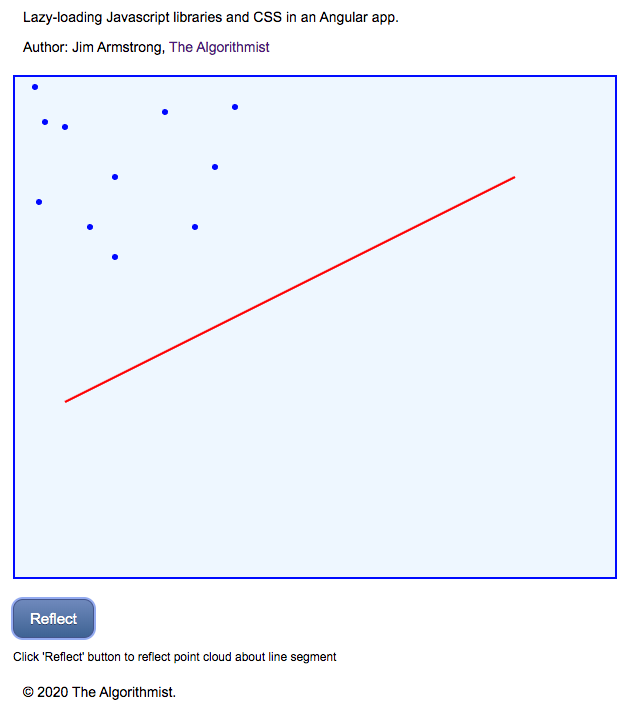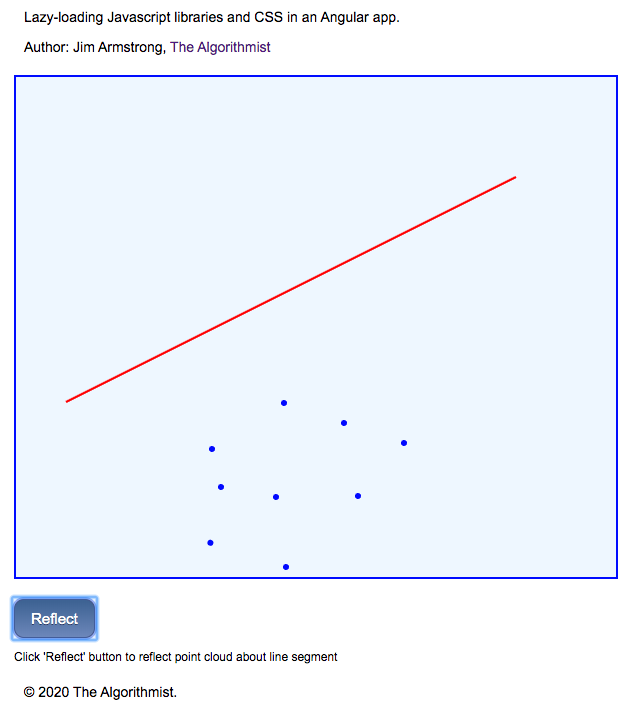This repo illustrates the complete end-to-end process of lazy-loading both external libraries (.js) and styles (.css) from an Angular 9 Component. A 'lite' version of my client-only Angular Dev Toolkit lazy-loading library is provided with the distribution. Error handling a couple very minor features have been removed from the client-proprietary version of this library.
Author: Jim Armstrong - The Algorithmist
@algorithmist
theAlgorithmist [at] gmail [dot] com
Typescript Library: Beta 1.0
Angular: 9.0.0
Angular CLI: 9.0.1
Typescript: 3.7.5
Pixi JS: 4.8.1
The specific problem illustrated in this example is reflecting a 2D point cloud about a line. An external library is loaded to perform the necessary computations. This simulates a situation when an infrequently-used Component (likely in an already lazy-loaded route) loads its resources 'on demand' so that they are only present in the application if they are actually used.
I took a few of the classes in my proprietary Typescript Math Toolkit and edited the compiled JS, output from the Typescript compiler. Specifically, I removed all the module/export code and the require statements. Two of the TypeScript 'classes' are straight functions in the JS code; the primary utility class is an IIFE. The code was concatenated by hand into a library in /src/assets/libs/point-libs.js. External code and styles should be in a folder that is copied to the dist folder when the application is built. I always tend to use the assets folder. You will see there are libs and styles sub-folders.
An attribute directive is used to display the point cloud and line segment in a PixiJS Canvas. The main app component lazy-loads the point-libs.js file, some external CSS, and the display is updated after external resources finish loading. Since the drawing-area display is contingent on successful load of external resources, referencing the attribute directive and updating the display is more complex than would normally be encountered in an Angular application.
Now, error-handling is not considered in the demo as I can not publicly release the exact same copy of code that has been used in proprietary client applications. Such handling is, however, easy to add and is left as an exercise.
Three Typescript 'classes' are provided in the /src/assets/libs/point-libs.js file. The primary utility of interest is TSMT$PointUtils. The Typescript compiler compiles all 'classes' down to IIFE in the Javascript file. There is also a TSMT$Point function in the file that is present as a straight function. TSMT$PointUtils was left as an IIFE.
This code distribution shows how to work with both TSMT$Point and TSMT$PointUtils. There is no interface or definitions file for the former, so we have to rely on some prior knowledge of the functionality provided by that object. An interface for the point utilities 'class' is provided in /src/app/shared/point-utils.ts.
The lazy-loading library is provided in /src/app/shared/libs/lazy-load-libs.ts. A single public method, load, is provided to lazy-load an external file that must have either a 'js' or 'css' extension. An Observable is returned that can be subscribed to for indication of when the loads are complete. Completion of this Observable indicates that the loaded script has already been assigned to a </script> tag in the document. Styles are handled in a similar manner.
Since we can't display anything until external resources are loaded, the Component's template has a 'loading' section. This is similar to examples you have likely seen in the past,
<ng-template #libsLoading>
<p>Loading libraries ...</p>
</ng-template>
<div *ngIf="libraryRef else libsLoading">
<div class="mt10 mainContainer main-border" reflect></div>
<button class="blue-button mt10" [disabled]="!available" (click)="onReflect()">Reflect</button>
<p class="instruction">{{instructions}}</p>
</div>
The main UI is not fully displayed until after a complete load of all external resources. The 'Reflect' button is disabled until we have a completely defined reference to the attribute directive used to control the display.
While a ViewChild would normally be used, ViewChildren is used in the application as the directive display is not deterministic; it varies over time. ViewChildren defines a QueryList that has a changes Observable to which we can subscribe. This informs us exactly when the view child is available for reference.
@ViewChildren(ReflectDirective)
private _reflector: QueryList<ReflectDirective>;
.
.
.
public ngAfterViewInit(): void
{
this._reflector.changes.subscribe( () => this.__onReflector() )
}
.
.
.
private __onReflector(): void
{
// extract the view child from the view children collection and indicate it is available for use
this._pointReflector = this._reflector.first;
this.available = true;
// draw the initial point cloud and reflection line
this._pointReflector.drawPoints(this._pointCloud);
this._pointReflector.defineLineSegment(this._x0, this._y0, this._x1, this._y1);
// this all happens well outside the normal Angular component lifecycle due to lazy-loading external JS and CSS
this._chgDetectorRef.detectChanges();
}
Loading of external resources happens outside the Angular Component lifecycle and in a manner that does not automatically trigger change detection, so the latter is done manually.
This component requests the external resources in its on-init handler,
public ngOnInit(): void
{
forkJoin([
this._loader.load('assets/libs/point-libs.js'),
this._loader.load('assets/styles/container-styles.css')
]).
subscribe( (arr: any[]) => this.__onLibraryLoaded(arr) );
}
The most important code occurs in the __onLibraryLoaded() handler,
private __onLibraryLoaded(arr: any[]): void
{
// TSMT$PointUtils is an IIFE
this._pointUtils = window['TSMT$PointUtils'];
if (this._pointUtils !== undefined)
{
this.libraryRef = true;
// example usage
const d: number = this._pointUtils.l2Norm({x: 0, y: 1}, {x: 1, y: 0});
console.log('distance between (0,1) and (1,0) is sqrt(2):', d);
// TSMT$Point is a function; we don't have a definitions file or an interface for a TSMT$Point, so it has to be typed to 'any'
const point: any = new window['TSMT$Point'](1, 1);
console.log('point length:', point.length());
}
}
After loading, anything defined in the external script file is available as a property in the global (window) scope. Since TSMT$Point is a function, it must be instantiated (constructor invocation). TSMT$PointUtils is an IIFE, so it is available for immediate use, 'as is'.
Nothing new - ng serve and localhost:4200. The initial UI appears as follows,
Click on the 'Reflect' button to reflect the point cloud about the line segment,
To get more help on the Angular CLI use ng help or go check out the Angular CLI README.

